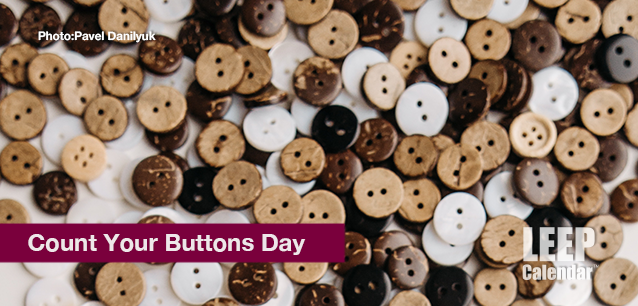 AD
AD
Today is: January 22
Scroll to explore events active on this date.
Additional Events on LEEP
LEEP INK FEATURES

Part II
There are several unique focuses for 2025. I covered the first 12 in Part One. The following are the rest I have discovered for this year. As with all issues of LEEP Ink, the following descriptions are a...

January—It is a New Year!
We've arrived at another new year; the older I get, the more frequently they come. When I was younger, years seemed to take a long time to pass. Now, they're just a blip—here and gone. For ma...

2025 is the Year of...
21 Themes and 'Year of' Events for 2025 PART ONE, THE FIRST 12 Every year, various organizations announce the theme for the year. These themes can focus on causes, such as aesthetics and color tre...
About Count Your Buttons Day
United States
Ends: Oct 21, 2025
DESCRIPTION:
Historically, counting your buttons equated to measuring your wealth.
HISTORY OF BUTTONS
Buttons originated in the Indus Valley, in what we now refer to as Pakistan, around 3000-2000 BC. The first buttons, made of shell or bone, were ornamental rather than functional, and they adorned garments like beads or broaches do today. Think about the costumes of ancient Rome, Greece, Persia, and even China you see in films. Ancient civilizations used ties, buckles, belts, pins, and thread to hold garments together—no buttons in buttonholes securing garments on those period pieces. I bet you never noticed that before, but now you will!
When did we start using buttons to fasten our clothes? In the 11th century. German tailors began using buttons with loops and then sewn holes in the fabric (buttonholes) to secure clothing for aristocrats, a revolutionary advancement in drapery allowing for a customized fit. The new technology and the more figure-flattering styles spread throughout Europe's upper classes, leading to the first Buttonmaker's Guild opening in France in 1250 AD.
During the middle ages and into the Renaissance, buttons conveyed wealth. One could tell a person's social class by the number of buttons sewn into clothes and their quality. Most were custom-made, with each button representing a little piece of art formed of precious stones and metals. Less affluent people made buttons using molds and liquid metal or rescued them from discarded garments. Thieves and spies hollowed out buttons to smuggle gems and messages. With the inauguration of George Washington as the first president of the United States, he popularized the use of "political buttons," buttons styled to showcase a person's political party.
The standard button of today includes four holes, is flat and round, a mass-produced style beginning in the 1840s. Automation during the industrial age made the production of buttons inexpensive.
Why do men's and women's shirts have buttons on different sides?
That goes back to the aristocracy. Since buttons were used by the wealthy, and the wealthy had servants and staff, women's buttons face left, so they were easier for the maid or another person to undo or do. Men generally self-dressed, so their buttons are right-facing, making them easier to close and open without assistance.
VIDEOS
Currently, this event does not have supporting videos.
SUPPORTING DOCUMENTS
Currently, this event does not have supporting documents.
ADDITIONAL IMAGES
Currently, this event does not have supporting images.
Where would you like to go now?
 AD
AD


/footer-logo.svg)
